There’s little I like more than searching through archives to find out more about the Brontës and the time and places they knew. That’s why my favourite section of my new book, ‘Crave The Rose: Anne Brontë At 200‘ is the one which contains a series of first person encounters with the Brontës, rescued from the archives and old newspapers. I’ve had lots of people tell me how much they love that section too, and the book as a whole – thank you.
I was reminded this week, however, that I also have lots of archive pictures and stories relating to the Brontë Parsonage in Haworth itself. Thanks go to Paul Mellen who emailed me the link to a story on the British Newspapers Archive blog looking at the history of the parsonage. It seems a perfect time then to share some of these pictures that I’ve collected over the years – some incredibly atmospheric, some fascinating glimpses into social history, and all great fun to look at.
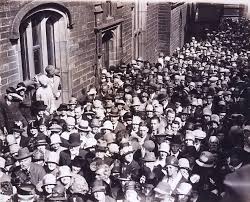
Let’s begin with the beginning of the Brontë Parsonage Museum itself. In this picture we see the huge crowds of people queueing to enter the parsonage when it first opened its doors in August 1928. I love the cloche hats worn by many of the women, so typical of the 1920s in Yorkshire, as well as in Jazz Age New York.
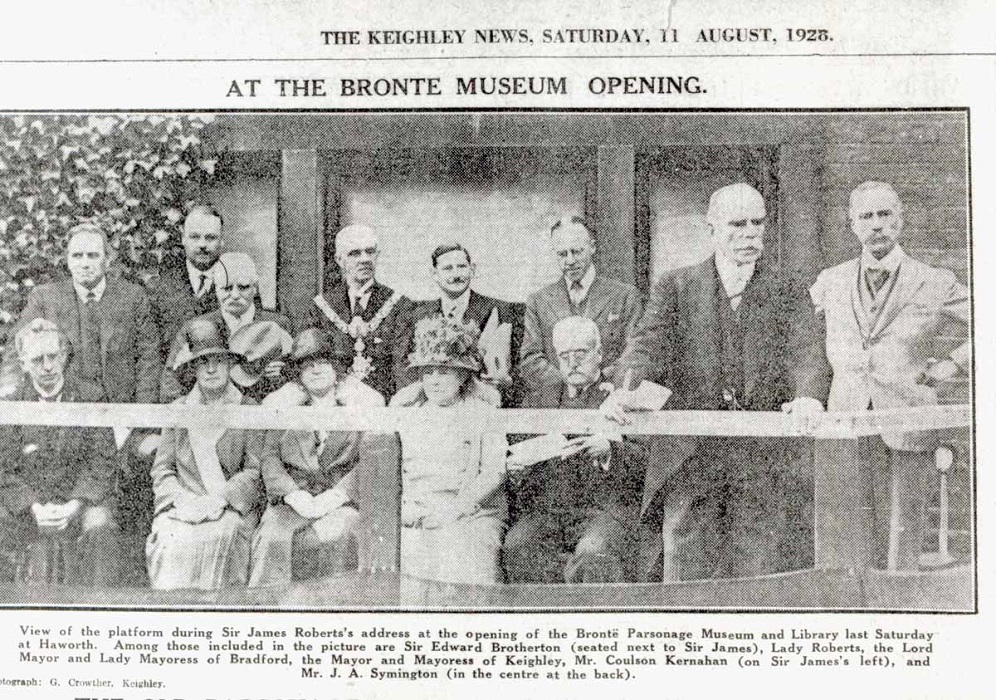
In this picture we see Sir James Roberts addressing the crowd on this momentous day – it was he who had very generously bought the parsonage from the Church of England and then gifted it to the Brontë Society to house their museum. A lovely report of this time reveals that after Sir James handed the title deeds over his wife, Lady Roberts, was handed a bouquet of white moorland heather by a young girl – Lady Roberts stooped to kiss the girl and “this little human touch called forth enthusiastic hurrahs, and even cheers.” I particularly like the end of that article too, detailing some more of the special guests in attendance: “The interest of the occasion was not a little heightened by the announcement that Captain Arthur Branwell, and Mr. and Mrs. Branwell, relatives of the Brontë family, as well as Mr. Holland, grandson of Mrs. Gaskell, were present, and they were invited by Sir James to ascend the platform, to say a few words.”
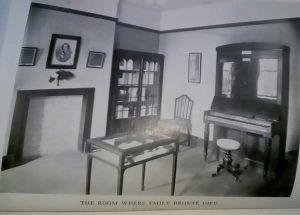
This picture shows us what the Brontë Parsonage Museum looked like in the months after its opening – it comes from the 1929 biography A Short History Of The Brontës by K. A. R. Sugden. Entitled ‘The room where Emily Brontë died’ we can see that the actual couch where she took her final breath, now a very moving highlight of the museum, was not yet in the museum’s collection, and the upright piano marked the spot.
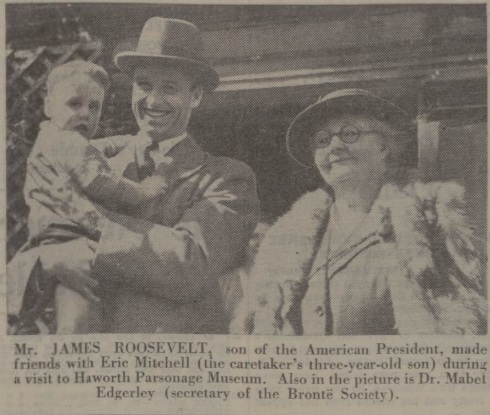
Sir James Roberts was the first of many illustrious visitors to the museum throughout the decades (Virginia Woolf visited Haworth before the parsonage became a museum), from Charlie Chaplin to Orson Welles, Sylvia Plath, Daphne du Maurier and Patti Smith. Perhaps unique in its history, however, was the visit in April 1939 of James Roosevelt – the son of the President of the United States of America! Roosevelt, the son of FDR, was in Brontë country in his capacity as an employee of Samuel Goldwyn Productions who were about to release their ‘Wuthering Heights’ movie starring Laurence Olivier and Merle Oberon. Officially he was an ‘administrative assistant’ for the movie company, but in reality of course he was one of Goldwyn’s right hand men.
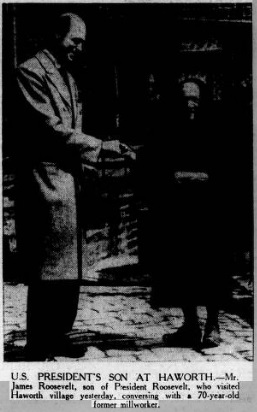
Roosevelt’s arrival in England (he also went to Manchester) was looked on almost as a Presidential visit in its own right, as his father was paralysed and unable to travel (this was kept a closely guarded secret from the American electorate, as was the fact that it was his wife Eleanor who carried out many of his Presidential duties). I love this picture of James Roosevelt meeting an old Haworth woman – two very different worlds brought together by the Brontës.
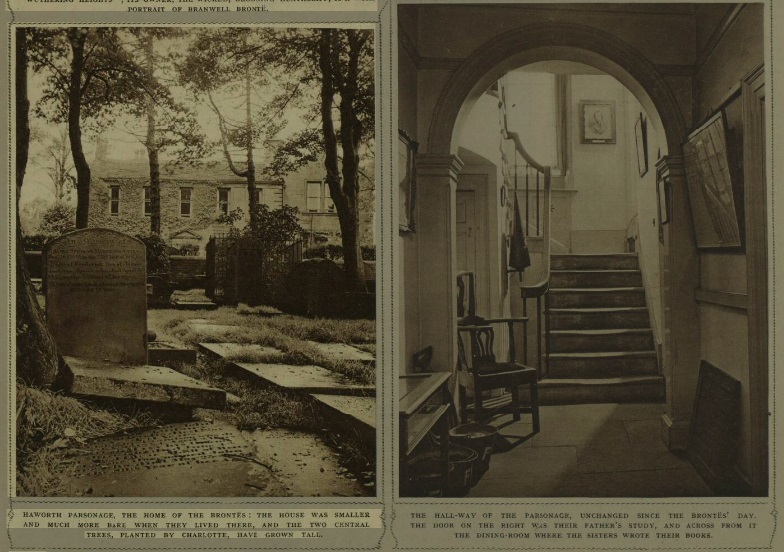
James Roosevelt served with distinction in the Second World War after his father led the United States decisively into the fray. The Parsonage Museum remained open throughout the war, and was also used as a cinema that showed films to soldiers stationed nearby. Here we see the Parsonage and its hallway in 1944, note that Patrick Brontë’s grandfather clock has not yet taken up its position on the middle landing of the stairs.
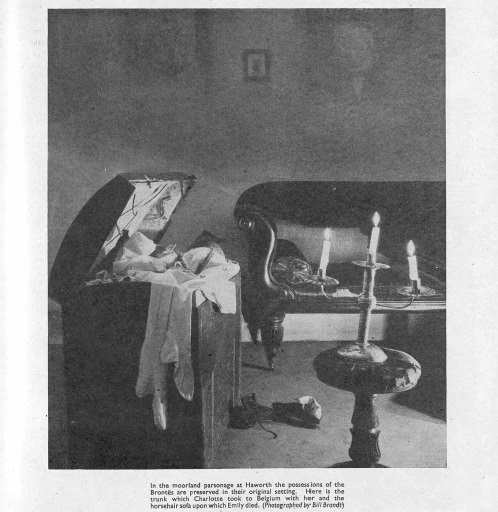
From Britannia And Eve magazine eight years later comes this, perhaps the most atmospheric picture inside the parsonage I’ve ever seen. It could almost be a portrait, but in fact its a photograph by Bill Brandt, dark and evocative – Emily’s sofa is now in place illuminated by candlelight. Charlotte’s shoes are on the floor next to her trunk, as if she is about to return at any moment.
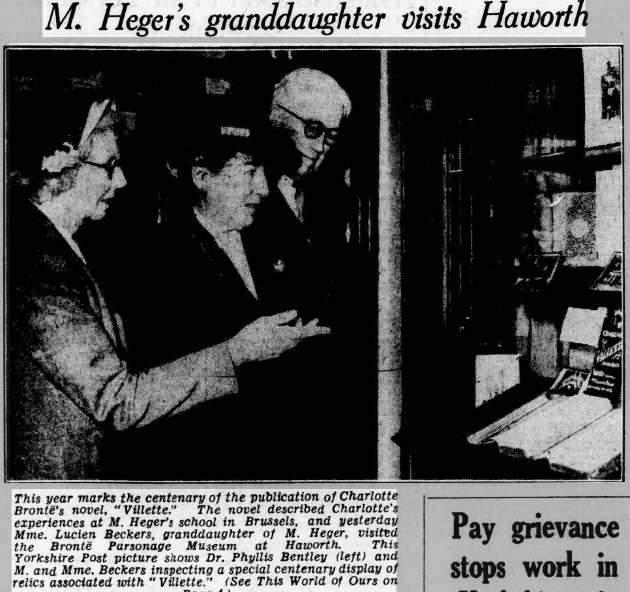
In 1953 we see another very special guest being shown around the Parsonage Museum – Madame Beckers, who has travelled from Belgium. She was the granddaughter of Clare and Constantin Heger, founders of the Brussels Pensionnat graced by Charlotte and Emily Brontë. We learn that Mme. Beckers, then in her 80s, forgave Charlotte for the less than flattering way that she’d portrayed her grandmother as Madame Beck in Villette – published a hundred years earlier. The report also states that when younger Mme. Beckers looked so much like her grandmother Clare that a former pupil of the Pensionnat had burst into tears upon seeing her. What would Charlotte have made of this visit?
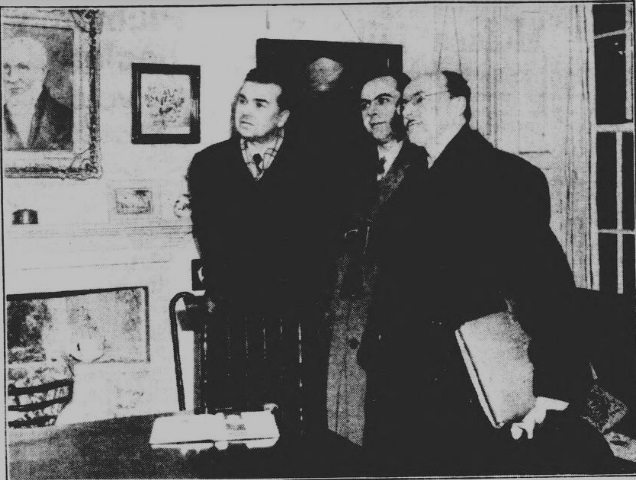
In 1954 we see yet more guests being given the VIP treatment as they are shown around the Brontë Parsonage Museum. As the cold war really starts to take a grip, a Russian cultural delegation has come to Haworth – showing how much Russians love the Brontës, a love which still continues to this day. We may be tempted to think that these three are spies of one sort or another; they may well be, but the man on the left is actually Leonid Leonov, one of the greatest Russian novelists and playwrights of his time and a man who was awarded the Order of Lenin on six occasions.
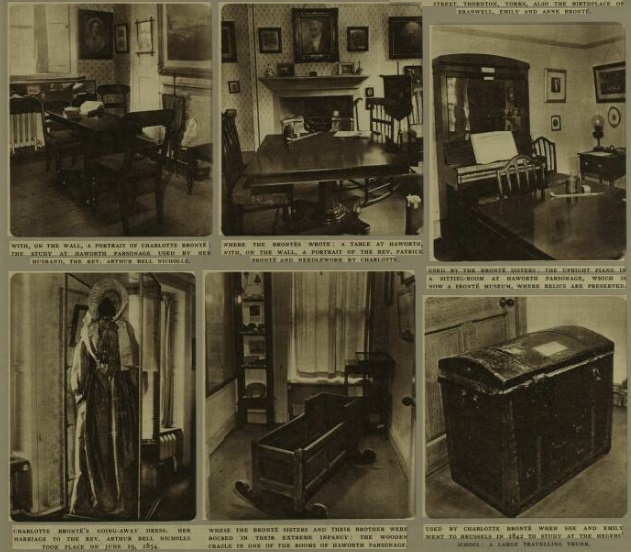
1955 at the Brontë Parsonage Museum was devoted to the marking of the centenary of the passing of Charlotte Brontë, and here we see six pictures from inside the museum during this special year. One item shown here is very rarely displayed now, but I find it an incredibly moving piece of history – the wooden cradle in which the infant Brontës slept.
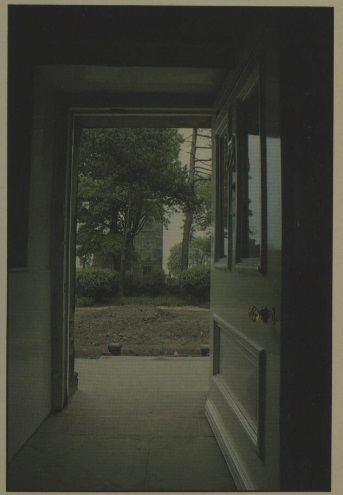
Finally we come much closer to our present time and the Brontë Parsonage Museum as we now know it – from 1980 we get a rare photographic view from inside the parsonage hallway looking out towards the church, a view the Brontës must have seen every day. It’s from this same edition of the Illustrated London News that we get this image of Haworth graveyard.
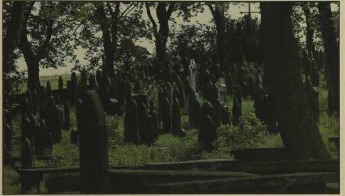
We finish this post then with a burst of colour; the Brontës continue to bring colour into our lives, and always will do. By the way, any emails, comments and suggestions are always welcome – I’m currently thinking of ways to allow you to become even more engaged with my blog, as I value the input of every one of my readers so much – thank you! I hope you’ve enjoyed this dip into the archives of this magical building!
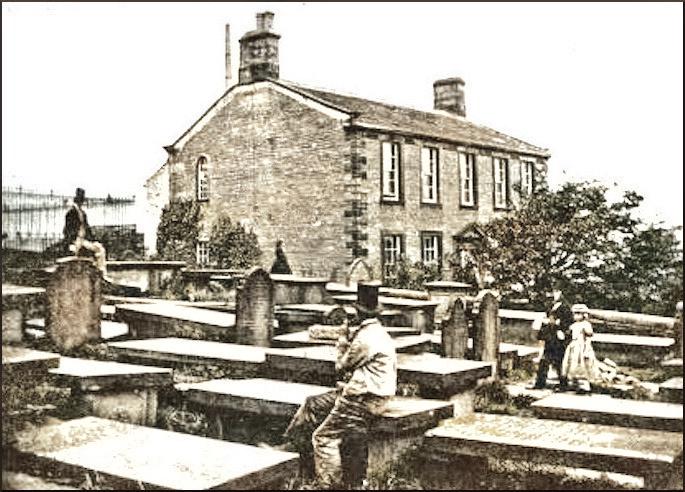
Thank you for such an interesting read and some magical photographs !
Fascinating! IMO, Charlotte must have been spinning when M. Heger crossed her threshold!
I particularly love the open door…
A wonderful archive of photographs you have – thank you for sharing, much enjoyed. It would have been great to see a photograph among your collection of the three sanguine portraits of Charlotte, Anne and the ‘Bonnet Portrait’ displayed on the Parsonage wall, listed as numbers 67, 68 and 69 in the Bonnell Catalogue – there are two b/w photographs of them to my knowledge? It’s ‘funny’ how 67 and 68 are after genuine portraits of Charlotte and Anne – but the third portrait of ‘Emily’ has been historically rejected as bogus without any grounds whatsoever. It would be hugely refreshing for a Bronte expert such as yourself – to explain the reason why the ‘Bonnet Portrait’ is reviled so in the upper echelons of The Bronte Society without good reason – any reason in fact – perhaps it could be the basis for a post? especially as the subject of the ‘Bonnet Portrait’ of Emily never gets raised except by myself and Christopher Heywood. Think about it!
I love these! Thank you!
This was a most interesting read, thank you.
I remember visiting the parsonage when I was around 5 in 1958. I clearly remembered a cradle. I next visited in my 60s even contributing to the rewrite of Wuthering Heights for an art project. I was sad not to see the cradle but looking at this site I’m amazed to see the actual cradle I remember nearly 63 years later! What happened to it I wonder?
I often wonder why it’s not displayed these days – perhaps it’s too fragile?
Thank you. It was as if I were there.
Deeply moving but luminous.
Dear Inês,
I hope you may be interested to know that being an ardent devotee of Charlotte Brontë, and matters Brontëana, I wrote Charlotte Brontë. An Irish Odyssey. The book of 280 pages is a celebration of Charlotte and Arthur Bell Nicholls wedding trip in 1854, and is now available on Amazon.
With kind regards,
Michael.
Dr. Michael O’Dowd, PhD (History) MD FRCPI FRCOG FRSM FICOG DCH DA.